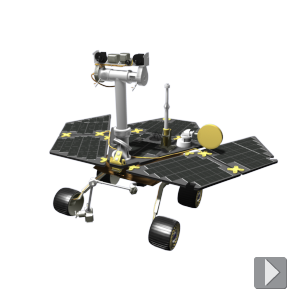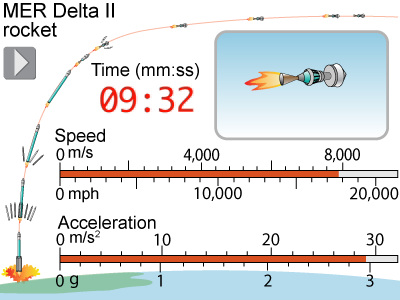|
 Human exploration of Mars has been a dream of writers and scientists for many years. The dream drew inspiration from colorful reports that astronomers had seen irrigation canals or seasonal vegetation on Mars. Today, of course, we know that the planet is colder, dryer, and windier than the harshest desert on Earth: No farmers, canals, or crops are anywhere to be seen. But is Mars entirely lifeless? Could it support a human outpost? To find out, many believe, we must set foot on its dusty soil. And that can’t happen until we know what it takes to bring people to Mars—along with many tons of supplies and shelter.
Human exploration of Mars has been a dream of writers and scientists for many years. The dream drew inspiration from colorful reports that astronomers had seen irrigation canals or seasonal vegetation on Mars. Today, of course, we know that the planet is colder, dryer, and windier than the harshest desert on Earth: No farmers, canals, or crops are anywhere to be seen. But is Mars entirely lifeless? Could it support a human outpost? To find out, many believe, we must set foot on its dusty soil. And that can’t happen until we know what it takes to bring people to Mars—along with many tons of supplies and shelter. 
|
 With the help of unmanned spacecraft, in the past half-century we’ve learned quite a bit about reaching Mars and working there. The first such spacecraft simply cruised past the “red planet,” snapping pictures along the way. The next generation entered into orbit around Mars, ultimately mapping its entire surface. A third generation reached the planet’s surface, telling us about its environment and showing us its rocky plains. Now a fourth generation of mechanical Martians is roving about the red planet, exploring craters and searching for signs of past or present life.
With the help of unmanned spacecraft, in the past half-century we’ve learned quite a bit about reaching Mars and working there. The first such spacecraft simply cruised past the “red planet,” snapping pictures along the way. The next generation entered into orbit around Mars, ultimately mapping its entire surface. A third generation reached the planet’s surface, telling us about its environment and showing us its rocky plains. Now a fourth generation of mechanical Martians is roving about the red planet, exploring craters and searching for signs of past or present life. 
|
 As you learned in the investigation on orbits, the Earth (and everything on it!) circles the Sun at a speed of roughly 30,000 m/s (67,000 mph). But you need to travel at an even higher speed to overcome the Sun’s gravity and reach the more distant orbit of the red planet. The Spirit rover got the needed boost from the launch rocket, from booster rockets that fired shortly after launch, and from much smaller engines on the spacecraft itself.
As you learned in the investigation on orbits, the Earth (and everything on it!) circles the Sun at a speed of roughly 30,000 m/s (67,000 mph). But you need to travel at an even higher speed to overcome the Sun’s gravity and reach the more distant orbit of the red planet. The Spirit rover got the needed boost from the launch rocket, from booster rockets that fired shortly after launch, and from much smaller engines on the spacecraft itself. 
 |
Newton’s third law tells us that two interacting objects push or pull each other with equally strong forces (the action and reaction forces, which actually operate at the same time). Try this: Sit in a rolling chair with a heavy backpack in your lap, lift your feet off the floor, and toss the backpack quickly to a friend standing in front of you. You’ll find that you roll at least a few centimeters in the other direction. What’s more, this happens whether or not your friend catches the backpack! The backpack is accelerated by one force (call it the action) and you by the other force (the reaction). You aren’t pushing against your friend—he or she doesn’t even need to be there, except to protect your pack! Likewise, a rocket isn’t propelled because its exhaust gases push against the launch pad or Earth’s atmosphere. Rather, it is propelled by a reaction force, which is just as strong as the action force pushing the exhaust outward. The same principle explains how a stranded spacewalker can reach her ship by tossing equipment in the opposite direction, even in the airless vacuum of outer space. 
|
How long does it take to reach Mars? The answer is that it depends on the exact alignment between Mars and the Earth at the time of launch. Typical travel times are between 130 and 300 days, where the longer travel times are for heavier payloads. That’s a long trip, and it’s only one way! 
|
If the rocket reached a velocity of 8,000 m/s after 10 min, what was its average acceleration?
 |
The time is expressed as 10 min, which converts to 600 s. Since the initial velocity of the rocket was zero, we can use the equation v = at. Solving it for acceleration, we get a = v/t = (8,000 m/s)/(600 s) = 13.3 m/s2. 
|
Using the average acceleration you just derived, what was the total distance traveled during those 10 min?
 |
Under the assumption of constant acceleration of a = 13.3 m/s2, the distance traveled is d = ½at = ½(13.3 m/s2)(600 s)2 = 2.4×106 m = 2,400 km. (The actual distance traveled was somewhat different, because the actual acceleration was not constant—as you can see in the animation!) 
|
| |
|

